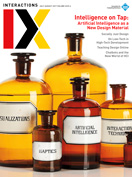Authors:
Simone Barbosa, Gilbert Cockton
As Interactions approaches its first quarter-century, it has grown with the academic and professional disciplines of human-computer interaction (HCI) and interaction design (IxD). Once the magazine enters its second quarter-century, it will continue to broaden as long as HCI and IxD continue to evolve, adapt, and reform. And yet even at the close of Interactions' first half-century, there will be continuities that have held some things constant irrespective of the changes and challenges to come.
Much of the breadth of this issue is familiar ground. We have features on conference accessibility (Ladner and Rector) and the enduring importance of low-tech artifacts in an ever higher-tech world (Marmalek). We chronicle design innovations in Demo Hour and How Was It Made?, and present concerns about educating and enabling current and future interaction design specialists (Designers' Speakeasy column, HCI Education and Design as Inquiry forums). We also tackle creative preschool education (Universal Interactions forum). For each educational focus, challenges arise due to the diversity of those being educated and/or enabled. At one level, the need for education remains a constant, but at another, the changing nature of those being educated, and the manner in which they are educated, introduce new challenges.
Interactions needs to share more early-career experiences as a counterbalance to those of the default well-established sages.
Some of what we cover in this issue is not new but nevertheless remains relatively underrepresented in HCI and IxD. The Evaluation and Usability forum addresses issues in the Global South, and Community Square presents Namibian perspectives on responses to these and other challenges. The Community + Culture forum discusses social change and justice through IxD and HCI. None of these topics is yet mainstream, so there is still work to be done in achieving balance here across each year of Interactions content. In this sense, change will have to be a constant for sourcing articles for Interactions.
There are three new contributions to breadth in this issue. The first is Ann Light's What Are You Reading? with a very broad range of books read and unread. The second is Nina Wei's feature on her experiences as a relatively young IxD specialist in Baidu's artificial intelligence (AI) research center. Interactions needs to share more early-career experiences as a counterbalance to those of the default well-established sages. The third debut of sorts is Day in the Lab, where Colorado Information Science's "lab" is an entire department, working across computational social science, digital humanities, crisis informatics, digital identity, personal information management, philanthropic informatics, data ethics and policy, network science, machine learning, information visualization, and diversity and inclusion in STEM. This is neither HCI nor IxD as we have come to know it, and thus it is no surprise to see their research extending to human-data interaction. Together, these new directions set us up for this issue's main focus: AI and big data.
Our cover story, Confessions column, and two features (Kostakos and Musolesi, Følstad and Brandtzæg) consider the prospects for AI and big data in research and practice, as well as their potential impacts on the future directions of HCI and IxD. Wei's feature provides a balancing perspective on AI design from a young professional, while the Interaction and Architecture forum explores the positive reflective benefits from smart objects.
What is clear across this issue are the constants and continuities, and some changes that will or must follow in the face of emerging challenges. What is not clear, unsurprisingly, is where this is all headed, but as professionals or researchers we can shape this future as it emerges. Sometimes, however, it will all be one big blur. But as we close with this issue's Visual Thinking Gallery, we can reflect on how often a big blur can actually make some things really clear.
Simone Barbosa and Gilbert Cockton, [email protected]
Copyright held by authors
The Digital Library is published by the Association for Computing Machinery. Copyright © 2017 ACM, Inc.








Post Comment
No Comments Found